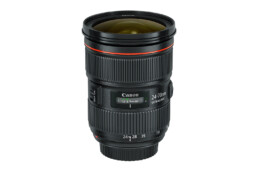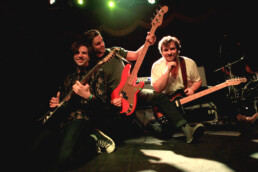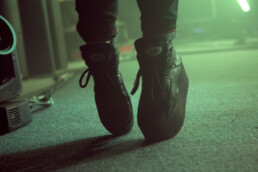
At smaller club shows, the key factors affecting what lenses to bring will be your proximity to the stage and in many cases, a very dark environment. For the most part, you can assume you will be pushed up against a low-to-the-ground space where the talent is performing, with no real barricade separating the artist, the crowd and you.
This type of venue gives you great access to angles you may not otherwise be able to photograph, such as shots from side-stage if the space wraps around, or ultra wide shots showing the talent’s entire bodies and the floor they are standing on.
If you are a new photographer (or a photographer who understands that shooting small club shows tends to be the most fun), these are our recommendations for lenses to bring.
In this gear guide, lenses are listed from most important to less important, meaning you could make do with just the first piece of glass on this list.
Standard Zoom (24 to 70 or 24 to 105)
Nine times out of ten, you will want to start your kit with a standard zoom that allows you to capture both wide and tighter shots in low light. A 24-70 will most likely be your best bet because of the darker environment, but in some settings you may be OK with a 24-105, allowing for a bit of extra length.
In a crowded floor, keep in mind that changing lenses will be tougher than in a designated photo pit and you may lose precious time doing so. You also may be squeezed into a single spot for the night, meaning you will be better served with a lens that can capture different shots from the same place.
Starting off with a Zoom also sets you up well to capture all of your “staple” shots, such as the drummer, each performer, and so on before moving into other focuses.
These lenses tend to be some of the priciest on the market, but they are incredibly functional and work well for event photography, weddings, video work and portraiture too. You will be better served investing in a single, high-quality zoom than piecing together several cheaper lenses.
The Nifty Fifty (50mm Prime)
If you purchased a kit that came with a 18-55 lens or something similar, and are looking to add one additional piece of gear that will help with club shows, a 50mm prime is your best bet. You can often scoop these lenses up for less than $100 and you will find that the low light capabilities are especially essential in dark rooms.
50mm lenses come in a few variations, but in many cases the f/1.8 option will be just fine. Depending on the manufacturer, you can find lenses that go down to f/14, or even f/1.2. Of course, with the wider aperture, price increases steeply.
Shooting with a prime lens is a fun challenge in framing and composition. You will be forced to build great shots with what you’re given and the experience channels old-school film shooting, where settings had to be more dialed in before shooting.
You will, unfortunately, miss a few key shots with a prime lens set up. If an artist crowdsurfs, kicks or does any other movement that would be best captured with a wide lens, you’ll likely miss them. However, at the price, it’s hard to beat a 50mm.

Ultrawide Zoom (10-18mm or similar)
One of the key club shots is the iconic ultra wide shot of a vocalist literally up against your lens, with the full stage behind them. The only way to get this wide is a lens essentially pushing the limit and approaching fish-eye status. While you wouldn’t want to rely only on this type of lens, you will get some special, one of a kind shots if things align!
Zooms and primes are both worth considering, and many third party manufacturers make ultra-wide lenses (sometimes without autofocus) that can be helpful for a single frame or a couple shots. Since this isn’t your key lens, autofocus is helpful but may not be essential.
Ultrawide lenses are also great portrait lenses for the same reason. You can distort an artist in frame, and really capture the environment behind them.
What To Leave At Home
In most cases, you won’t need the 70-200 zoom that is a staple for many other venues. Unless you want to get a few shots from side stage or back of the house, you will simply be too close to the action for this type of lens to be helpful. You will also find yourself bumping up against those around you with the lens, and be adding a ton of extra weight to your bag or pack.
You’ll also want to leave any flashes or external accessories at home. Of course, you can’t shoot live music with a flash anyway, but at club shows you really want to make your camera body and your footprint as small as possible.
Finally, leave your backpack at home and invest in a shoulder bag or something that can go to your side or in front of you. This will make changing lenses, grabbing extra batteries, or finding a spare memory card easier. While you may want to use this type of bag in all settings, at a club it is especially essential because people will be pushed up right behind you for much of the show.





